Here’s your chance Ricky Bobby, it’s that moment you’ve been waiting for. You get to go as fast as you want with only your skills holding you back. Are you ready?
There is not a thing in this world that compares to riding a motorcycle on a race track. It’s reminiscent of watching a hungry predator in its natural habitat. A man (or woman) fully in touch with their machine without a distraction in the world – except Street Rossi behind you with a chip on his shoulder. Anyways, Street Rossi aside, a track day is the perfect opportunity to hone your riding abilities in a traffic-free environment. On a track, you have fewer potential hazards like road debris, distracted drivers, or surprise changes in road conditions. A track is a well-groomed and maintained piece of pavement with one purpose in mind. Go fast.
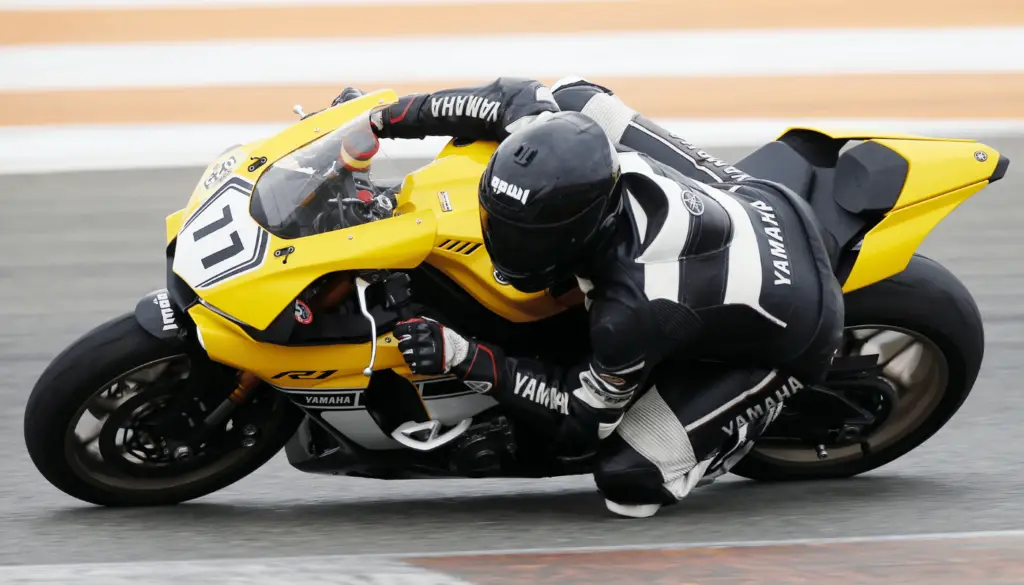
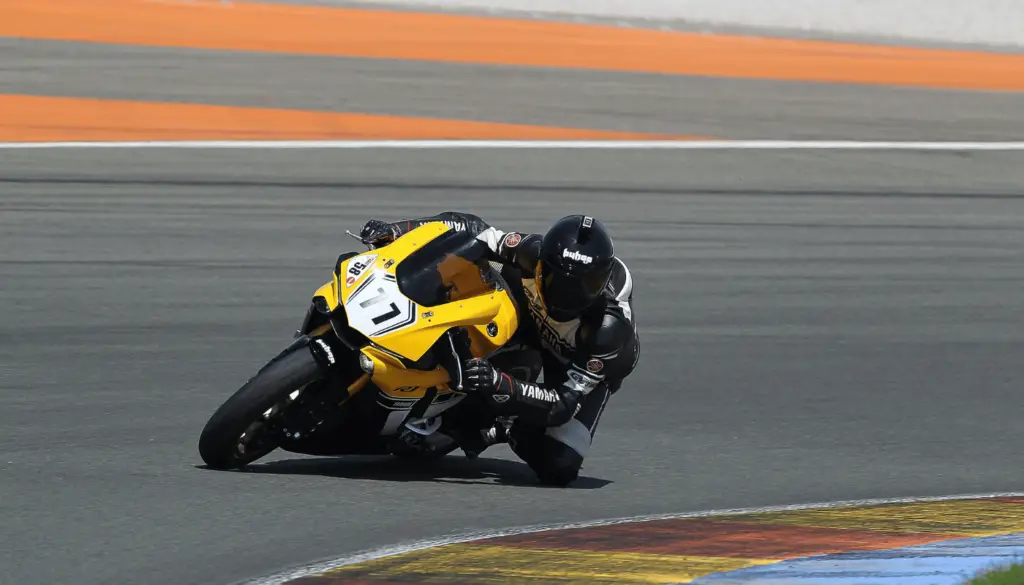
Y’all wouldn’t believe how hard it is to start a blog from scratch.. if you found any value from this article, please share it on social media!
Taking just a few seconds to share can make a world of difference for new creators like myself!
What is a Motorcycle Track Day?
For the uninitiated, the simplest explanation is that a motorcycle track day is an organized ride on a race track. These events are typically hosted by a 3rd party organization, such as Sport Bike Track Time for casual track days or WERA Road Racing for organized competitive racing. These are only two examples, there are countless other organizations across the world that host motorcycle track days. Essentially, these organizations lease the racetracks for one or more days and organize the events. If your intention is to race, race weekends will be hosted true to the name – across the entirety of a weekend.
How To Register For A Track Day?
Registering for a track day will vary by organization but it is typically the same as any other application process. The organization that is available to you will greatly depend on your location. Your access to certain tracks will also vary by your location. Oftentimes, there will be local Facebook groups that have organized to communicate with other track-minded riders in the area. Maybe do some due diligence prior to registering. Find some Facebook groups, inquire with riders you know personally, or even call your local motorcycle shop to inquire. Many shop owners or employees have been to the track at least once or twice in their lives. Once you’ve determined your track, and related organizer, you can proceed to the organizer’s website to apply. You will register and pay (yes, you have to pay an entrance / sign-up fee. This will vary by location, organizer, and track.) through the organizer’s website. You will need to enter information such as your personal information, motorcycle details, information on whether you have ridden a track day before, whether you have ridden a track day in that organization and if so what is your best time at that track.
Why Do They Need So Much Information?
Organizers request personal information about you because they need to assess your personal risk and skill levels. Remember that motorcycling is a dangerous hobby and is relatively safer on a track, but still poses its risks, particularly when inexperienced riders are mixed with those more experienced.
You will need to enter information such as your personal information, motorcycle details, information on whether you have ridden a track day before, whether you have ridden a track day in that organization and if so what is your best time at that track.
Based on this data, the organizer will place you in one of the three to four groups at the very beginning of the event. Groups typically fall into similar categories as Novice, Intermediate, Advanced, and Expert. This is done for safety reasons. As I mentioned, a novice rider poses a significant threat to a more experienced rider as there are rules and etiquette on the track that a novice may not be familiar with. More so, novice riders can be unpredictable due to their inexperience. Faster riders will typically brake later from a higher rate of speed, which leaves a small margin of error. This lack of reaction time can create opportunities for collisions between novice and more experienced riders.
If you are a beginner, be transparent with the organizers of the event. They will try to provide you with as much information as possible.
If you intend to race, the classes may vary depending on the organization. To race competitively in an organization, you will be required to obtain a motorcycle race license through a credentialed race school. Do take note that race licenses will be accredited and applicable only to certain organizations. You will want to verify the particular license requirements for each organization prior to any further action.
Preparing For A Motorcycle Track Day
Preparing for a track day can be particularly daunting. There are a lot of variables, necessary preparation, and associated risk with the activity. Your first event can take over your schedule with ease, but should be accommodated as adequate preparation is incredibly important. If it’s your first time on the track, you don’t need to prepare anything special for your first track day. Don’t expect to be racing others, or trying to set lap times, focus instead on yourself. Focusing on yourself will allow you to hone your riding skills which will give you more enjoyment during the track day, but also more safety when on the road. You may be talented, and fast enough, on your first day but trust me when I say – do not get in over your head. Accidents happen quickly and there is never as much time to react as you would hope.
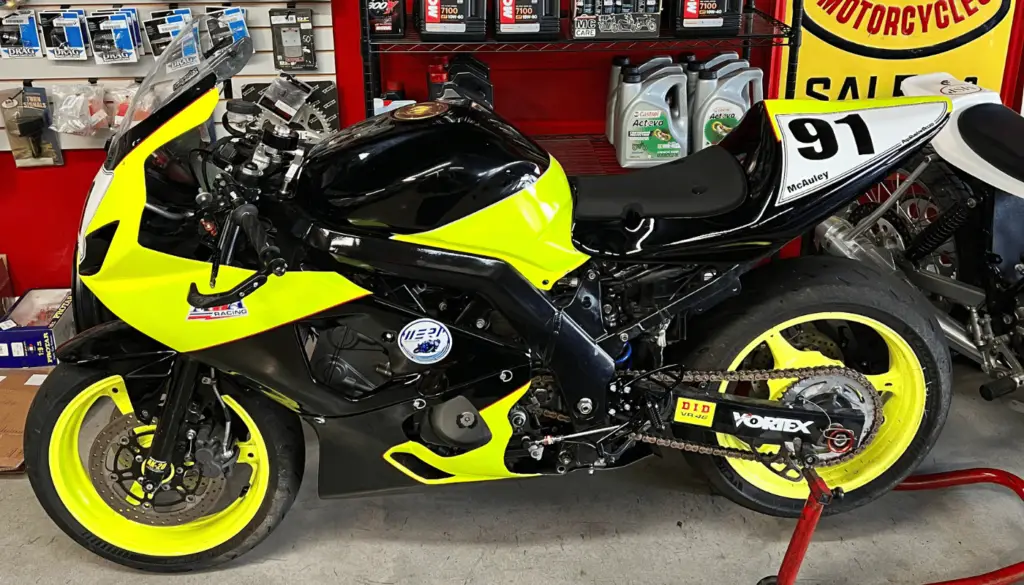
Motorcycle Preparation
Preparing your motorcycle should consist of double-checking all technicalities on your bike. Nothing should be hanging from the motorcycle, all screws should be fastened and torqued appropriately – safety-wired if applicable. Check the brakes, and replace the brake fluid if it is old. If you ride a powerful motorcycle and need a lot of braking, it is better to replace old brake fluid preemptively. Old brake fluid can overheat, leading to a reduction in braking capacity. Also, check the brake pads and replace them if they are close to being worn out. Prior to any further servicing, you will want to make sure that your motorcycle is not leaking in any way. Many organizations will not allow you to pass technical inspection with an ongoing leak as it can create a hazard for other riders. All of these methods are best completed when your motorcycle is cleaned properly. As they say, the devil is in the details.
Tires
Your tires are one of, if not the, most important part of your bike. Your tires provide you grip and stability at high rates of speed, so you will want to make sure they are appropriately aired and not prematurely worn. Be sure to set your air pressure at a place where the tires have room to warm up. You will want to let your tires warm up before any aggressive riding as the tire compound is designed to create the most grip when warm. This also factors in the rise in air pressure from the heat that is generated. Some people suggest running slicks but you can also choose to run a dual compound tire that is DOT approved, but more so a slick on the outer edges – where you’ll spend most of your time.
Chain & Sprocket
You’ll want to pay close attention to your chain & sprocket. They are the mechanisms that allow you to put power to the ground. They’re the final drive components in your powertrain. Check your chain for any kinks, tight spots, or missing o-rings (seals). Make sure it is clean and in-spec of manufacturer-recommended chain slack. A stretched chain can break, and a loose chain can create unpleasant surprises in a jerky throttle response. When exiting a corner, you want the smoothest throttle input possible. A jerky throttle is one of the fastest ways to get yourself into an accident on the track. Check your sprockets for wear or any broken teeth. As a sprocket wears it will begin to develop a crescent moon type shape on the teeth.
Motor Oil
Check the oil level, and if it hasn’t been changed recently, it would be a good idea to change the oil and filter. Track day motorcycles require an oil change more frequently than road-going motorcycles. Oil manufacturers base their oil change recommendations on standard motorcycle use; track days certainly do not fall into this criteria. During a track day, your bike is spending most of its time in the higher RPMs and is therefore taking more abuse than it would see otherwise. Some people run race-specific motor oil like Motul 300v, and some opt to use a high-grade synthetic such as Motul 7100 – my personal recommendation. If your bike burns oil, I would recommend checking your oil level every other session. Oil will be burned at a faster rate due to the increased load on the engine.
Fork Oil
A track motorcycle’s suspension is almost the most important factor in a motorcycle’s performance. Many dedicated track day riders opt for upgraded internals for their shock and forks, but for every rider, you should remember to maintain your forks appropriately. This includes changing your oil & dust seals along with the fork oil as necessary. A fork service should be completed routinely, some suggest as often as every other track day.
Coolant
The coolant is another item that should be checked. For most it is unexpected but most track bikes do not overheat without an ongoing mechanical problem. Since you’re moving at a higher rate of speed, more air is flowing through your radiators which increases the cooling ability of your motorcycle. Many track / race bikes do not have a radiator fan at all. Otherwise, it is good practice to routinely change your coolant. You do not want to run the risk of rust in your water jacket, as it can create catastrophic engine failures over time.
Fuel
It can be pretty obvious, but you will want to make sure that you have at least a half-tank of gas with a decent supply of gas for any necessary refueling. Additionally, if you have a track only motorcycle, you will want to make sure that it has not been sitting for long periods of time. If ethanol gas sits idle for too long, it will lead to the deterioration of rubber materials (hoses and seals) and can lead to performance-related issues from ethanol deposits in the fuel system.
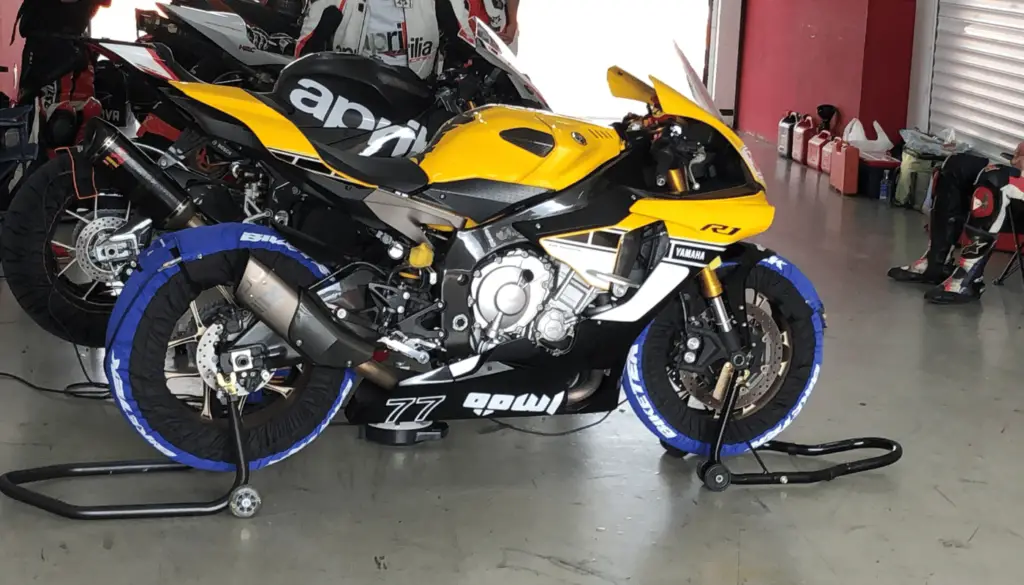
Personal Preparation
Safety Gear
For your own sake, and also because most organizations will not let you race without it, you will need to get a full leather race suit with a back protector (often sold separately), riding gloves, riding boots, and a full-face helmet that does not have any sunglasses or additional visors. Some people opt for a 2-piece leather suit, but I personally prefer a 1-piece.
Track Day Supplies
Motorcycle Related Supplies
Since we are being inclusive of beginners interested in their first track day, I will mention the specifics and bare minimums that you may need for your first track day. I will also include a full kit that more experienced riders and racers may employ.
Necessary
- Motorcycle Chock (I recommend an E Track Motorcycle Wheel Chock, if you have a trailer. A Baxley Sport Chock if you do not and a motorcycle ramp for on/off loading)
- Motorcycle Straps / Tie-Downs (Rhino USA for the most durable)
- Front and Rear Motorcycle Stands
- A tool kit applicable to your bike (for any trackside repairs – which do happen)
- A large capacity fuel can with bendable hoses (for trackside refueling)
- Tire pressure gauge
Full Kit (Optional for Beginners)
- Tire Warmers
- Spare wheels with additional tires (slicks, normal extras, or rain tires)
- Change in gearing (different sprocket sizes will have benefits depending on the track)
- Safety wire (for any tech inspection adjustments as necessary)
Personal Supplies
Many of the same personal rules that apply to the road also apply to the track. You will want to make sure that you’re hydrated and well-fed at all times. Do not overeat, overeating can lead to sluggishness and premature fatigue. I recommend that you bring sunscreen. While you’re mostly covered, there are certain exposed areas on your body that are susceptible to being burned. Bring extra snacks and water, again do not eat too much. Along with water, it would be wise to bring an electrolyte solution that does not contain sugar. An elevated blood sugar level can cause adverse reactions when under stress. You do not want to experience a sugar crash in the middle of a session. I prefer to use compression wear under my suit but just make sure that you have clothes to wear under your suit and a change of clothes for when you’re finished riding for the day. Don’t forget a comfortable change of shoes.
Motorcycle Track Day Insurance
It may be difficult, but it is possible to find an insurance policy that will cover your track day motorcycles. They are recreational vehicles, after all. Before searching for a provider, I would suggest that you use a motorcycle insurance estimator to get a general idea of the cost.
Otherwise, with the specificity of the policy, I would recommend that you contact an insurance broker to locate a policy suitable for you.
Motorcycle Track Day Checklist
| Item | Check (Y/N) |
| Leather Suit | |
| Riding Boots | |
| Gloves | |
| Fuel Can | |
| Front & Rear Stands | |
| Helmet | |
| Tire Warmers | |
| Spare Wheels & Tires | |
| Personal Items (Snacks, Water, Electrolytes, Deodorant, Clothes) | |
| Toolkit | |
| Motorcycle Chock | |
| Straps & Tiedowns | |
| Motorcycle Ramp |
Mental Preparation
Most of us picture ourselves flying around the tracking, dragging knee & elbow, all while laughing at our fellow participants. This couldn’t be further from the truth, most times. Even I was faster than I expected – more so in comparison to my peers. My success was, unfortunately, short-lived. My aptitude for riding did not exceed my inexperience. Coming into a double-apex left-hand turn, I have my first high-side crash ever, leaving me benched for the remainder of the day, and my Suzuki SV650 in need of extensive repairs. Remember that your expectations will likely exceed reality when it comes to motorcycling. Measure yourself accordingly. Do not go out there with the intention of breaking lap times or pushing yourself to your limits.
Oftentimes, you will find exactly where your limits are, and this discovery carries with it dire physical consequences. Spend time on your technical skills, such as body position, brake markers, corner entry/exit, throttle application, trail braking, etc.
If possible, before you go to a track day, carefully watch any available onboard videos of riders that have been on that track previously. Take a map of the track and plot the braking markers and the paths these drivers took. That way you won’t waste less time getting to know the track and you’ll be able to get down to the riding technique faster. This happens when you’re focusing on your current position as opposed to focusing on the move after next. After watching the videos and plotting on the course map, try to close your eyes and imagine going through each corner and coming to each brake marker. In other words, visualization is key.
As with many things, adequate preparation is the number one denominator for safety and success.
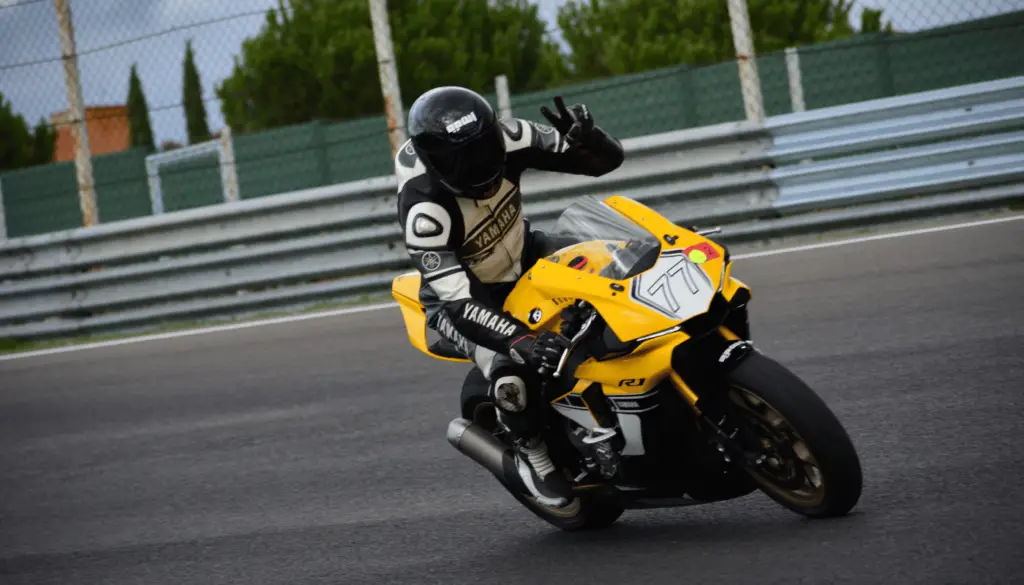
Ending Notes
Remember that the primary goal, for any track day or race alike, is to make it through safely to ride again another day. The track can be the perfect place to hone your skills as a novice or to further progress as an expert. It does, however, depend on how you take advantage of the opportunity. Never have an ego, and open yourself up to learning experiences. The track-riding community can be quite the fraternity. They will support you as you would never expect and teach you things you would never learn otherwise. Be respectful, humble, and willing to learn at all times. You will receive great things in return. Lastly, if ever in doubt, don’t be afraid to ask a professional.
Chase Manhattan signing off~